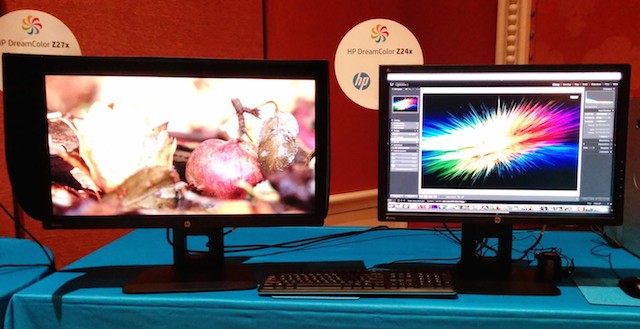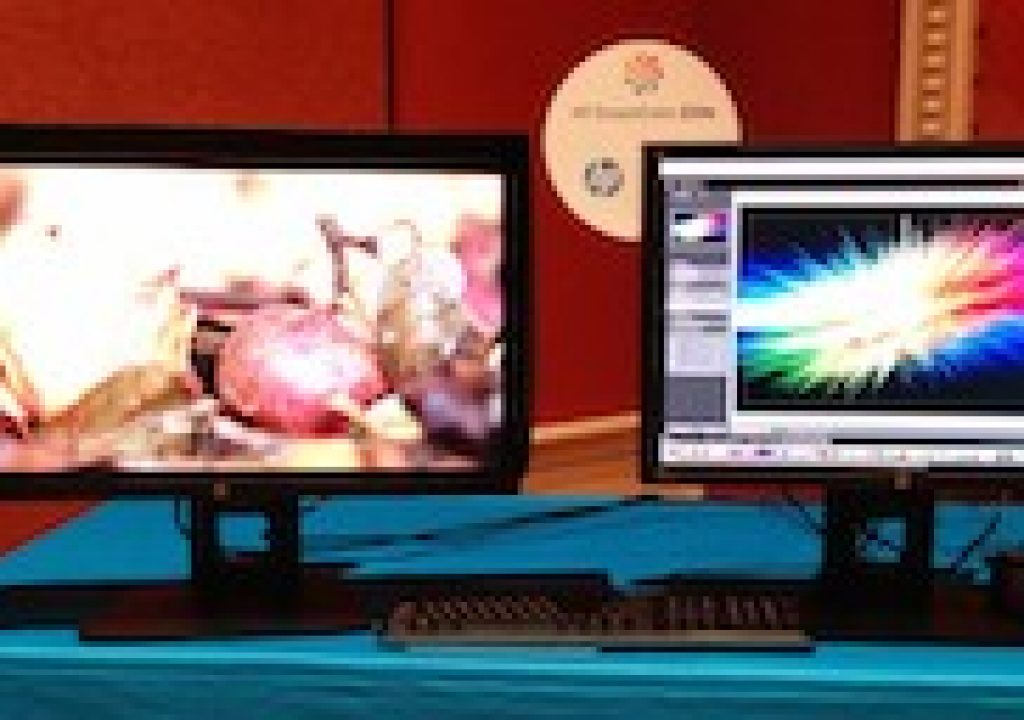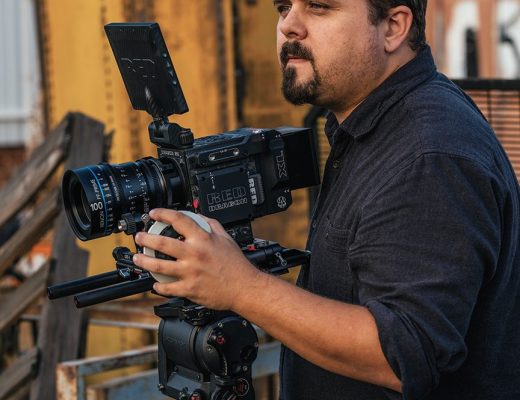
At NAB 2014 in Las Vegas, HP showed two new DreamColor monitors with plenty to write home about! The new “pro” Z27X model has a larger 27“ diagonal panel, accepts up to a 4K signal, and costs substantially less than the original DreamColor monitor. Ahead I’ll explain many of its other improvements, together with some details on the new Z24X 24” “little brother” model, which is now the entry-level DreamColor monitor.
DreamColor monitor model numbers
Since 2009, I have published over a dozen articles about the original LP2480zx DreamColor and its proper integration in a video production system. That original LP2480zx DreamColor monitor has a long and difficult model number to remember. The two new models are much simpler to recall:
- The new Z27X, which is the professional 27″ model which can even accept 4K video signals (plus more other new benefits) and has an official price of US$1499
- The new Z24X, which is the new entry-level 24″ model (details ahead in this article) and has an official price of US$599
Over 1 billion colors (in US nomenclature)
Like the original LP2480zx DreamColor, both of the new models have 10-bit (aka 30-bit) panels, which means that they can display 1.07 billion colors, or more precisely 1,073,741,824 colors. How did we come up with that number?
Each pixel in any color LCD monitor contains three subpixels. Each subpixel corresponds with one of the three primary video colors: red, green, and blue. The bit-precision of the display determines how many levels of brightness can be shown for each primary color. A 6-bit monitor offers 64 (26) levels from darkest to brightest for each primary color. An 8-bit monitor offers 256 (228) levels for each primary color. The bit-precision is determined by the electronics which control the liquid crystal cells in the panel. Since there are three subpixels, the maximum number of colors that a pixel can display is 2n x 2n x 2n where n is the bit-precision of a subpixel. Therefore, an 8-bit panel offers 28 x 28 x 28 = 16,777,216 colors (which is often rounded as 16.7 million). Many consumer LCD monitors have inexpensive 18-bit panels (6-bit per subpixel x3). Most professional LCD monitors have 24-bit panels (8-bit per subpixel x3). Only a very few high-end LCD models have 30-bit panels (10-bit per subpixel x3). Since the DreamColor LP2480zx, Z24Z, and Z27X all have a 10-bit panel design, they can all display a simultaneous palette of 210 x 210 x 210 = 1,073,741,824 colors which is often rounded to 1.07 billion colors… but be careful of the billion term, as explained ahead:
Beware the term billion in international circles
That number you just read is expressed with the US billion nomenclature. In European English, that number would be written and spoken as 1,07 thousand million (except for those Europeans who have adopted the US billion)! Castilian readers should interpret it as 1,07 mil millones… or 1,07 millardos if they use very modern terminology. Both in European English and in Castilian, the term billion (or billón) is a much bigger number, with 12 zeros instead of 9.
What’s new (and good) in both new DreamColor monitors?
- Unlike the original LP2480zx DreamColor monitor, which has absolutely no audio connections, both of the new DreamColor models, the Z24X and Z27X, fortunately have an onboard audio DAC (digital-to-analog converter) output to connect your audio amplifier or active speakers, and they will be in sync with the video being monitored. This is vital if your professional video interface only offers combined digital audio/video over HDMI, and no analog audio output. The analog audio output of the Z24X and Z27X is unbalanced 3.5 mm TRS stereo, according to HP. That is good to keep in mind when choosing cables to run from the new DreamColor monitor to your powered speakers or amplifier.
- Unlike the original LP2480zx DreamColor monitor, whose DreamColor Engine absolutely demands both RGB and true progressive (no PsF or interlaced video is allowed), both of the new models, the Z24X and Z27X, can now accept interlaced video or progressive, and it can be component or RGB. (RGB is still preferred for grading if your system offers that option, but it is no longer a requirement for the DreamColor Engine. In upcoming articles, I’ll cover in what cases Blackmagic interface users will be able to remove the “Band-Aid”, and and what cases they may want to keep it for the moment, even with the new DreamColor monitors, and why.) Details about interlaced video with each new model, ahead in this article.
What’s new (and good) in the Z27X, the new pro model?
This is only a a partial listing for this “first look” article, and is in addition to the benefits already covered above:
- The new US$1499 Z27X can now receive up to 4K video over HDMI or DisplayPort input, although the panel’s native resolution is 2560 x 1440. We have several options, from seeing the entire 4K or Ultra HD signal mapped to the panel, seeing it 1:1, and several other options I’ll cover in my upcoming review.
- The Z27X no longer requires absolutely any external computer to be calibrated. Instead, you simply plug any of the supported colorimiters directly into the Z27X and let the inboard DreamColor Engine perform and save the profile. I have been awaiting this capability for a long time!
- Unlike the original LP2480zx DreamColor monitor, which unfortunately rounds non-integer source framerates like 23.976, 29.97 and 59.94 to the closest integer when reporting it on screen, according to HP’s DreamColor architect Greg Staten, the Z27X now fortunately displays them appropriately to that level of accuracy: 23.976, 24, 25, 29.97, 30, 50, 59.94 or 60, depending upon the source. I was not able to see that during the press event at NAB or make any screenshots, since the only source was exactly 24, but I will do that once I receive a review unit. This was the primary pet peeve I had with the original LP2480zx DreamColor monitor, and I am delighted to hear that it has been improved, since I believe that any good critical video monitor should be able to do that, in order to help the operator determine that everything is properly adjusted in the system, and with that level of accuracy, be it for video editing or grading.
- As stated previously, the Z27X can handle progressive or interlaced video without its DreamColor Engine going on strike (as happens with the original LP2480zx). That’s because both the Z27X and the Z24X feature an advanced motion adaptive per pixel de-interlacer. However, only the Z27X has the capability of disabling that de-interlacer, which is what I would do if working on progressive projects with that model.
- The Z27X has even better off-axis viewing than the original LP2480zx.
What we know so far about the Z24X
- The US$599 Z24X does not accept 4K video.
- The Z24X still requires a computer with Windows to be calibrated, although (like the original LP2480zx) the Z24X fortunately still stores the profile in its inboard DreamColor Engine, at least when being calibrated in pro video mode. At publication time of this article, there is no Mac calibration software to calibrate the Z24X, and there is no plan to create one. HP recommends the Z27X for Mac users. I’ll test calibrating Z24X with Mac and Boot Camp and with at least one emulation once I receive a review unit.)
- It is still unconfirmed whether the Z24X displays non-integer source framerates as accurately as 23.976, 29.97, and 59.94, or whether it rounds them to the closest integer, as the original LP2480zx does. I’ll test that once I receive a review unit.
- The Z24X has inferior off-axis performance compared with the Z27X and the original LP2480zx.
- The Z24X does not support DCI, although it does support 709.
Upcoming reviews of the Z24X and Z27X
After I receive the Z24X and Z27X review units, I’ll review them and publish my results.
Upcoming articles, reviews, and books
Stand by for upcoming articles, reviews, and books. Sign up to my free mailing list by clicking here.
Si deseas suscribirte a mi lista en castellano, visita aquí. Si prefieres, puedes suscribirte a ambas listas (castellano e inglés).
Allan Tépper’s books, consulting, articles, seminars & audio programs
Contact Allan Tépper for consulting, or find a full listing of his books, articles, and upcoming seminars and webinars at AllanTepper.com.
FTC disclosure
No manufacturer is specifically paying Allan Tépper or TecnoTur LLC to write this article or the mentioned books. Some of the other manufacturers listed above have contracted Tépper and/or TecnoTur LLC to carry out consulting and/or translations/localizations/transcreations. Many of the manufacturers listed above have sent Allan Tépper review units. So far, none of the manufacturers listed above is/are sponsors of the TecnoTur programs, although they are welcome to do so, and some are, may be (or may have been) sponsors of ProVideo Coalition magazine. Some links to third parties listed in this article and/or on this web page may indirectly benefit TecnoTur LLC via affiliate programs.
Copyright and use of this article
The articles contained in the TecnoTur channel in ProVideo Coalition magazine are copyright Allan Tépper/TecnoTur LLC, except where otherwise attributed. Unauthorized use is prohibited without prior approval, except for short quotes which link back to this page, which are encouraged!

Filmtools
Filmmakers go-to destination for pre-production, production & post production equipment!
Shop Now













